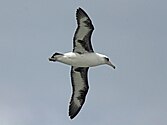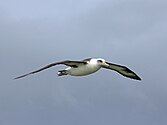Laysan albatross
| Laysan albatross | |
|---|---|
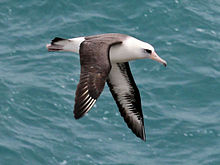
| |
| Scientific classification | |
| Domain: | Eukaryota |
| Kingdom: | Animalia |
| Phylum: | Chordata |
| Class: | Aves |
| Order: | Procellariiformes |
| Family: | Diomedeidae |
| Genus: | Phoebastria |
| Species: | P. immutabilis
|
| Binomial name | |
| Phoebastria immutabilis (
Rothschild, 1893)[2] | |
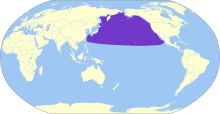
| |
| Synonyms | |
|
Diomedea immutabilis | |
The Laysan albatross (Phoebastria immutabilis) is a large
Etymology
It is named for Laysan, one of its breeding colonies in the Northwestern Hawaiian Islands.
Description
The Laysan albatross averages 81 cm (32 in) in length[4] and has a wingspan of 195 to 203 cm (77–80 in).[5] Males, which weigh 2.4 to 4.1 kg (5.3–9.0 lb), are larger than females, which weigh 1.9 to 3.6 kg (4.2–7.9 lb).[6][7] This albatross has blackish-gray upperwing, mantle, back, upper rump, and tail, and its head, lower rump, and underparts are white. It has a black smudge around the eye, and its underwing pattern varies between individuals, with some having narrower black margins and variable amounts of black in the underwing coverts. Finally, the bill is pink with a dark tip. Juveniles have a gray bill and a dark upper rump.[4] This species does not have a breeding plumage.[6]
The Laysan albatross is usually easy to identify. In the North Pacific, it is simple to separate from the other relatively common albatross, the all black black-footed albatross. It can be distinguished from the very rare short-tailed albatross by its all-dark back and smaller size. The Laysan albatross's plumage has been compared to that of a gull, two-toned with a dark gray mantle and wings and a white underside and head.
Distribution and habitat

The Laysan albatross has a wide range across the North Pacific, with 16 nesting sites. All but 0.3% of the breeding population is found among the Northwestern Hawaiian Islands, particularly the islands of
Behavior
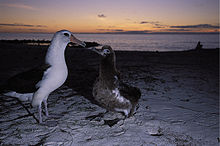
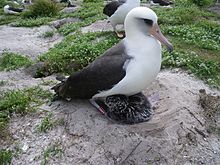
The Laysan albatross is normally a silent bird, but on occasion may be observed emitting long "moo"-ing sounds, descending whinnies, or rattles.[6] Female Laysan albatrosses may bond for life and cooperatively raise their young.[8]
A female Laysan albatross named
Reproduction
Laysan albatrosses are colonial, nesting on scattered small islands and atolls, often in huge numbers, and building different styles of nests depending on the surroundings, ranging from simple scoops in the sand[12] to nests using vegetation.[4] They have a protracted breeding cycle, and breed annually, although some birds skip years.[4] On Hawaiian Islands, breeding season typically lasts from November to July.[13] Juvenile birds return to the colony three years after fledging, but do not mate for the first time until seven or eight years old. During these four or five years, they form pair bonds with a mate that they will keep for life. Courtship entails especially elaborate 'dances' that have up to 25 ritualized movements.
Occasionally, the birds form same-sex pairs consisting of two females. This has been observed in the colony on the Hawaiian island Oahu, where the sex ratio of male to female is 2 to 3 and 31% of all pairs are between females. Paired females can successfully breed when their eggs are fertilized by males.[14] This phenomenon has been useful to conservation efforts in the Hawaiian Islands, where researchers have successfully swapped unfertilized eggs from female-female pairs with fertile eggs translocated from pairs nesting on military airfields and in other unsafe nesting areas. The female-female pairs then hatch and raise the foster chicks.[15]
The single egg is buff-white
The Laysan albatross and the black-footed albatross have been known to hybridize.[5][6] Like all albatrosses, the Laysan albatross is known to be a long-living bird. The oldest known live bird, a female named Wisdom, was at least 70 years old as of 2021[update].[17] In 2014 she hatched a healthy chick which is believed to be her 36th.[18][19] The longest lifespan confirmed for a wild seabird was for a breeding male found to have been banded 53 years previously. Other albatross are thought to match or maybe even exceed this record, but few confirmations of very old albatrosses exist.[20]
Feeding
The Laysan albatross feeds predominantly on
Conservation
| Breeding location | Breeding pairs | Trend |
|---|---|---|
| Midway Atoll | 441,178 | Stable from 1992 to 2005 |
Laysan Island |
103,689 | Stable from 1992 to 2005 |
| French Frigate Shoals | 7,073 | Stable from 1992 to 2005 |
| Other northwestern Hawaiian Islands | ||
| Tori-shima (Izu Islands) | 1,218 | Unknown |
| Bonin Islands | 23 | Unknown |
| Islas Guadalupe | 337 | Increasing |
| Other offshore Mexican islands | 63 | Increasing |
| Total | 590,926 | −30 to 49% over 85 years |
The
The Laysan albatross has an occurrence range of 38,800,000 km2 (15,000,000 sq mi) and a breeding range of 3,500 km2 (1,400 sq mi) with a population of 1,180,000 mature birds estimated in 2006.
In the past, harvesting for feathers was a major threat, along with high-seas drift net, but both of these have ceased, barring some small-scale illegal drift net operations. Current threats today are the longline fisheries.
Midway Atoll

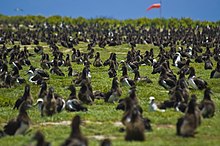
70% of the global population of Laysan albatrosses nest on Midway Atoll annually.[29]
In October 2009, an estimated 10,000 Laysan albatrosses nesting on Midway Atoll, part of the
"Laysan chicks raised in nests close to 90 buildings left behind by the Navy are ingesting lead-based paint chips. This is causing shockingly high lead concentrations in their blood, leading to severe neurological disorders, and eventual death," said George Fenwick, president of American Bird Conservancy. "Federal funds are urgently needed to clean up this toxic mess to protect the Laysan albatross, as well as future visitors to the new Marine National Monument."[31] As many as 10,000 chicks, or 5% of hatched chicks, may be killed annually by exposure to lead-based paint. Many Laysan chicks that nest within 5 m of building structures exhibit a condition referred to as "droop wing", which commonly manifests itself in the chicks’ inability to raise their wings, which then drag on the ground, resulting in broken bones, infestations of maggots, and open sores. Chicks with droop wing will never be able to fly and will die of starvation or dehydration. Other chicks in close proximity to buildings also suffer detrimental effects from lead exposure. These chicks have blood lead concentrations that cause immunological, neurological, and renal impairments, significantly decreasing their chances of survival.
The
In February 2010, the Center for Biological Diversity (CBD) announced an impending lawsuit against the United States Fish and Wildlife Service for violations of the Migratory Bird Treaty Act, the Endangered Species Act, and the Resource Conservation and Recovery Act.[30] By September of that year, the Fish and Wildlife Service made plans to spend $1.4 million on cleaning the lead paint at the Midway Atoll military buildings, with plans to spend more than $21 million overall to removed paint chips from the soil and clean 71 buildings in total; the American Bird Conservancy reported that the clean-up would begin by July 2011.[32][33] In 2011, the Fish and Wildlife Service announced its plans to begin the clean up of lead-based paint at federal facilities.[34] By 2016, more than 20,000 cubic yards of lead-contaminated soil had been treated. In August 2018, Midway Atoll was declared lead-free after a long campaign of remediating the buildings and soils.[35]
Gallery
-
AtKilauea Pointon Kauai, Hawaii
-
At Kilauea Point on Kauai, Hawaii
-
At Kilauea Point on Kauai, Hawaii
-
At Kilauea Point on Kauai, Hawaii
-
At Princeville, Hawaii
Footnotes
- ^ . Retrieved 11 November 2021.
- ^ Brands, S. (2008)
- ^ Robertson, C. J. R. (2003)
- ^ a b c d e f g h i j BirdLife International (2008)
- ^ a b c Dunn, J. L. & Alderfer, J. (2006)
- ^ a b c d Floyd, Ted (2008)
- ISBN 978-0-8493-4258-5.
- ^ "Gay animals going at it like rabbits". The Register. 17 June 2009.
- ^ U.S. Fish and Wildlife Service: Pacific Islands (5 February 2021). "World's oldest known, banded wild bird hatches chick at Midway Atoll". Medium.com. Archived from the original on 5 February 2021. Retrieved 6 February 2021.
- ^ Memott, Mark (6 February 2013). "Oh, Mama! World's 'Oldest' Bird Has Another Chick". NPR - The Two-Way. Retrieved 8 February 2013.
- ^ "America's oldest wild bird is a new mom". CNN. 9 March 2011. Archived from the original on 10 March 2011. Retrieved 9 March 2011.
The bird was first identified and banded by a USGS researcher in 1956 when she was incubating an egg, according to the USGS. As the Laysan albatross cannot breed before age 5 – and spends much of its life before that at sea – scientists estimate Wisdom is at least 60 years old. She may be even older, though, as most Laysan albatrosses do not breed until age 8 or 9 after an extended courtship...
- ^ a b Udvardy, M.D.F. (1994)
- ^ "Laysan Albatross | Audubon Field Guide". www.audubon.org. Retrieved 2023-10-20.
- PMID 18505710.
- ^ Young, L.C., VanderWerf, E.A., Granholm, C.A.T.H.Y., Osterlund, H., Steutermann, K. and Savre, T., 2014. Breeding performance of Laysan Albatrosses Phoebastria immutabilis in a foster parent program. Mar Ornithol, 42, pp.99-103.
- ^ Peterson, Roger Troy (1961)
- ^ May, Natasha (2021-03-05). "Wisdom the albatross, the world's oldest known wild bird, has another chick at age 70". The Guardian. Retrieved 2021-03-07.
- ^ Dell'Amore, Christine (21 February 2013). "Oldest Known Wild Bird Hatches Chick at 62". National Geographic Daily News. Archived from the original on February 23, 2013. Retrieved 3 March 2013.
- ^ Heimbuch, Jaymi. "At 63 years old, Wisdom the Laysan albatross hatches another chick". Retrieved 6 February 2014.
- ISBN 978-0-85112-235-9.
- ^ Pittman, et al. (2004)
- ^ Tickell (2000)
- ^ Harrison (1990), p. 57
- ^ Harrison (1990)(b), pp. 36–37
- ^ Flint (2007)
- ^ a b Naughton, et al. (2007)
- ^ Flint, B. (2003)
- ^ Gilman & Freifeld (2003)
- ^ Affairs, United States Congress House Committee on Natural Resources Subcommittee on Fisheries, Wildlife, Oceans, and Insular (2015). Is the Midway Atoll National Wildlife Refuge Being Properly Managed?: Oversight Hearing Before the Subcommittee on Fisheries, Wildlife, Oceans and Insular Affairs of the Committee on Natural Resources, U.S. House of Representatives, One Hundred Thirteenth Congress, Second Session, Thursday, November 20, 2014. U.S. Government Publishing Office. p. 7.
{{cite book}}: CS1 maint: multiple names: authors list (link) - ^ a b "U.S. accused in albatross chick deaths". NBC News. Retrieved 2022-12-12.
- ^ Environmental News Service (12 December 2006)
- ^ "Feds spending $1.4M on Midway lead paint clean up". Hawaii News Now. 6 September 2010.
- ^ Nakaso, Dan (19 July 2011). "Cleanup aims to save 10,000 birds each year". Star Advertiser. Retrieved 12 December 2022.
- ^ "Cleanup Launched to Stop Lead Poisoning of up to 10,000 Albatross Chicks Each Year on Hawaii's Midway Island". www.biologicaldiversity.org. Retrieved 2022-12-12.
- ^ Radko, Gemma (2018-08-17). "Millions of Albatrosses Now Lead-free on Midway". American Bird Conservancy. Retrieved 2022-12-12.
References
- BirdLife International (2008). "Laysan Albatross - BirdLife Species Factsheet". Data Zone. Retrieved 22 Feb 2009.
- Brands, Sheila (14 August 2008). "Systema Naturae 2000 / Classification - Diomedea subg. Phoebastria -". Project: The Taxonomicon. Retrieved 22 February 2009.
- del Hoyo, J.; Elliot, A.; Sargatal, J., eds. (1992). Handbook of the Birds of the World. Vol. 1. ISBN 84-87334-10-5.
- Dunn, Jon L.; Alderfer, Jonathan (2006). "Albatrosses". In Levitt, Barbara (ed.). National Geographic Field Guide to the Birds of North America (fifth ed.). Washington D.C.: National Geographic Society. p. 78. ISBN 978-0-7922-5314-3.
- Environmental News Service (12 December 2006). "Lead Paint Killing Birds in New Marine National Monument". Environmental News Service. Retrieved 4 July 2009.
- Flint, E. (2007). Hawaiian Islands National Wildlife Refuge and Midway Atoll National Wildlife Refuge - annual nest counts through hatch year 2007.
- Floyd, Ted (2008). "Tubenoses: Albatrosses, Shearwaters & Petrels, and Storm-petrels". In Hess, Paul; Scott, George (eds.). Smithsonian Field Guide to the Birds of North America (First ed.). New York, NY: HarperCollins Publishers. p. 81. ISBN 978-0-06-112040-4.
- Gilman, E.; Freifeld, H. (2003). "Seabird mortality in North Pacific longline fisheries". Endangered Species Update (20): 35–46.
- Harrison, Craig S. (1990). Seabirds of Hawaii. Cornell University Press. ISBN 0-8014-9722-1.
- Naughton, M.B.; Romano, M.D.; Zimmerman, T.S. (2007). A Conservation Action Plan for Black-footed Albatross (Phoebastria nigripes) and Laysan Albatross (P. immutabilis) (1st ed.).
- ISBN 0-395-13692-X.
- Pitman, R.L.; Walker, W.A.; Everett, W.T.; Gallo-Reynoso, J.P. (2004). "Population status, foods and foraging of Laysan Albatrosses Phoebastria immutabilis nesting on Guadalupe Island, Mexico". Marine Ornithology (32): 159–165.
- Robertson, C.J.R. (2003). "Albatrosses (Diomedeidae)". In Hutchins, Michael; Jackson, Jerome A.; Bock, Walter J.; Olendorf, Donna (eds.). Grzimek's Animal Life Encyclopedia. Vol. 8 Birds I Tinamous and Ratites to Hoatzins. Joseph E. Trumpey, Chief Scientific Illustrator (2nd ed.). Farmington Hills, MI: Gale Group. pp. 113–122. ISBN 0-7876-5784-0.
- Tickell, W.L.N. (2000). Albatrosses. Robertsbridge, UK: Pica Press.
- ISBN 0-679-42851-8.)
{{cite book}}: CS1 maint: multiple names: authors list (link - Waid, Robert, 2005 ed. The Majestic Albatross - Images of Kauai's Beloved Seabird
- Whittow, G. Causey (1993). "Laysan Albatross (Diomedea immutabilis)". In Poole, A.; Gill, F. (eds.). The Birds of North America, No. 66. The Academy of Natural Sciences (Philadelphia); The American Ornithologists’ Union (Washington, D.C.).
External links
- BirdLife species factsheet for Phoebastria immutabilis
- Photos of the Laysan Albatross at jostimages.com
- "Phoebastria immutabilis". Avibase.
- "Laysan albatross media". Internet Bird Collection.
- Laysan albatross photo gallery at VIREO (Drexel University)
- Interactive range map of Phoebastria immutabilis at IUCN Red List maps
- Audio recordings of Laysan albatross on Xeno-canto.




